Why is Admiralty different?
Primary tabs
Do you know that pointy junction on the edge of Wanchai? The one where Hennessy Road and Queen's Rd East merge and become Queensway? This one:
Come stand there with me for a moment, and look towards Admiralty. Notice anything different?
Just behind us in Wanchai you get big buildings, small buildings, old ones and new, all squeezed in together. It's the same when you get to Central too, but around Admiralty you just get skyscrapers from the 80's and 90's, or parks. Why is that?
Glad you asked! The Batgung time machine is just back from its 10,000-year service, so hop aboard and we'll see what we can find out. I've set the dials to 1843, and off we go!
I've also brought a few old maps [1] along with us to help us get our bearings. The red dot shows where you are standing right now.
1843
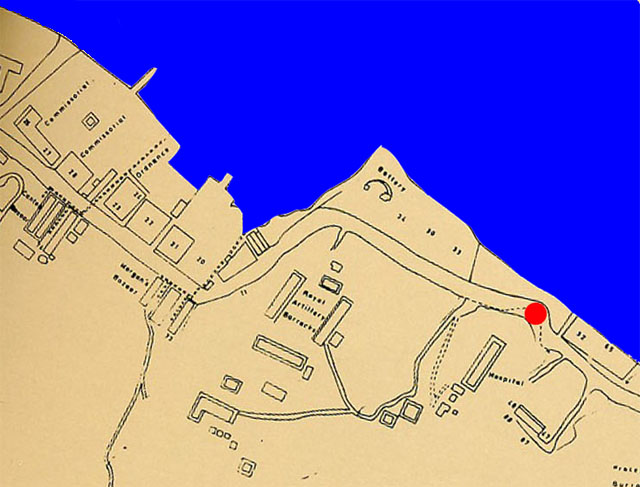
The first thing I notice as we step outside is the quiet. With no road noise we can hear the waves on the nearby shoreline. Look with me along the shoreline to that sharp point of land, and you can see a battery of guns has been set up to give some defense to the new city of Victoria. There's not a whole lot else for us to see though, so let's step back inside and set the dials to 1856.
1856
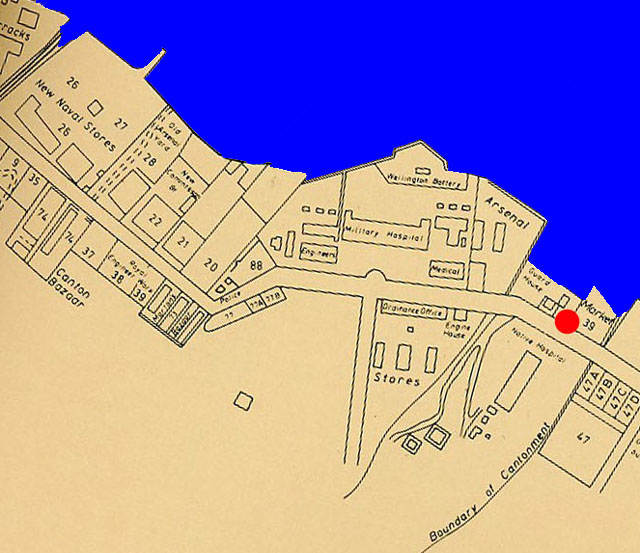
When we look outside again, it's clear that the army have been busy. The battery (now named Wellington Battery) has a sturdy wall around it, and has been joined by an Arsenal and a Military Hospital. If we walk along the road as far as the left edge of the map, we'll see the Navy are here too. So the military are keen to have a presence in the area, but the map shows several civilian buildings too, including the Canton Bazaar and Morgan's Bazaar.
We'll jump ahead to 1880, to see whether the military or civilians will prevail.
1880

It's not hard to see who won! The area we are looking at is called the Military Cantonment. From where we stand you can see the tower of St John's Cathedral in the distance. It is at the area's western boundary. Then if you look up the hill on our left you can see Kennedy Road, which forms the southern boundary. So the cantonment stretches from here to the cathedral, and from Kennedy Road to the sea.
If we take a stroll along Queen's Road and back, we'll find that most of the buildings are assigned to the army, with the Navy having to make do with a small Naval Yard. As you walk past the Naval Yard, look up to the left to see Headquarter House standing on a small promontary. A little further along the road and you'll see Murray House standing in it's original location.
To help you get oriented, here are the modern-day buildings that stand on some of the places shown on this map:
- Victoria Barracks >> Pacific Place
- Murray Barracks >> Citibank Tower
- Parade Ground >> Cheung Kong Centre
- City Hall >> HSBC building and Old Bank of China building
- Naval Yard >> Lippo Centre
Back at the time machine, we'll take a bigger jump forward. When we look out next, we're in the twentieth century just before the outbreak of the second world war.
1939
The hillside is still under the control of the army, and the buildings there haven't changed much in the fifty-something years since 1880. Out on the seaward side of the road there are big changes though. Faced with the limited land available to them, the Navy (or "Admiralty" as they are referred to on this map) did what any other Hong Kong resident would do - reclaim!
So we'll take the same walk along the road to Murray House, but this time we'll walk back along the shoreline to see what the Navy have been building. First we come to the cigar-shaped inlet shown on the map. It is a dry-dock, where a ship can enter, then a gate is closed so the seawater can be pumped out. It gives the engineers access to the parts of the ship that are usually below the water.
Next we come to a much larger dock. Roughly square shaped, it is known as a 'floating basin', and is also used for repairs and refitting of ships. The third and smallest dock is a mystery to me - can any readers explain what it was used for?
As we leave the military land and walk back along Arsenal Street, you'll note that the civilians have also been busy reclaiming land. Wanchai now covers a much larger area than it did in 1880. There have been a couple of reclamations since then, with the biggest in in the 1920's. That pushed the coast out from Johnston Road to Gloucester Road. It also means that Hennessy Road has replaced Queen's Road as the main East-West route through Wanchai, so our time machine is once again standing on a pointy road junction.
This was not a good place to be during the war, as the dockyards were natural targets for the attackers. First they were attacked by the Japanese during their brief invasion, but for a much longer time it was the American bombers who were attacking the area. Their aim wasn't always true, causing many casualties in nearby Wanchai. [2]
So let's skip ahead to happier times...
1964
Those pre-war years saw the military cantonment grow to its largest size. Britain's military power was steadily reduced after that, meaning less facilities were needed. If we were to walk along the shoreline now, we'd see that the two smaller docks have been filled in, and only the floating basin remains. There was no longer any need for a full-scale dockyard, so the navy scaled back to a more compact naval base in the late 1950's. This freed up a strip of land that they sold back to the government - you can see it on the map between the new Harcourt Road and Queensway. [3]
Ah, there's the name 'Queensway" in use for the first time. On our earlier visits the whole road was simply called Queen's Road, but now the road is named in the four sections.
This is just a brief stop, we'll move straight on to 1990. Careful you don't bump into the 1990 version of yourself!
1990
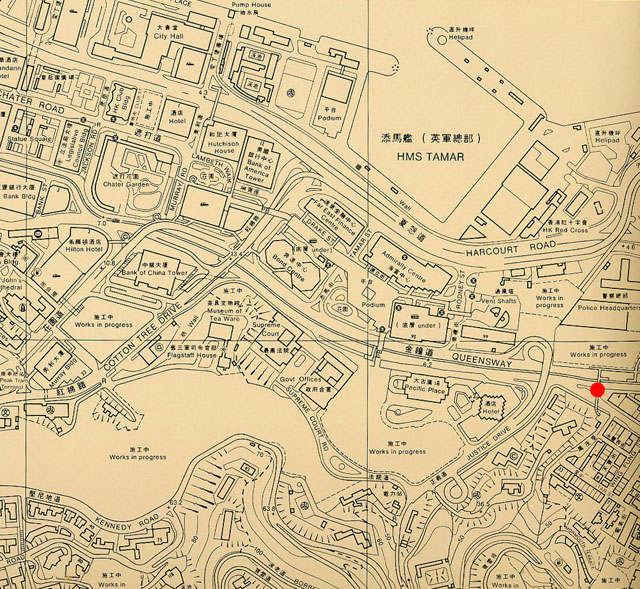
This all looks a lot more familliar - that kink in the middle of Queensway has finally been straightened out! If we look on the right side of Queensway the buildings are the same as you would see in 2007. On the left of the road the first phase of Pacific Place is complete, with the remainder under construction. Hong Kong Park is also being built. This southern area stayed under army control until 1979. [4] When they moved out, the government had a unique opportunity to develop a large open area of land right in the heart of the city.
Ready for our last step through time? And we're back to the present-day.
2007
There are still some signs of the Military Cantonment we saw on our earlier visits. The old Headquarters House (A) we saw in 1856 is still standing, but the name was changed to the current 'Flagstaff House' in 1932 [5]. The old magazine building (B) from 1880 is still there too, though it's tucked away up near Kennedy Road, so you may not have noticed it before. You can still see Murray House, but only if you go to Stanley! It was carefully taken apart from its original location, spent over a decade in storage, then rebuilt in Stanley in the 1990's [6].
A few names also give clues to the past. There's Arsenal Street (C) near the old Arsenal Yard, Harcourt Road (D) and Harcourt Garden (E) for a naval connection (Admiral Harcourt arrived with the British fleet in August 1945 to accept the Japanese surrender, then shortly afterwards he was appointed Commander in Chief of Military Administration.) [7], and of course the name Admiralty, the name of the old owner of the land between Queensway and the sea.
There remains a military presence, but it has shrunk again even since 1990. The PLA's Central Barracks (F) occupy what was previously HMS Tamar, though the floating basin (G) was filled in shortly before the handover. That now sits as the large, tarmac-covered 'Tamar Site', awaiting its fate.
To answer our original question, Admiralty is different today as a natural result of its very different history. The surrounding areas evolved according to the varied needs of government, industry, finance, commerce, and providing housing. Instead, Admiralty spent most of its life hidden away under the control of the army and navy, only returning to public life in the 1980's.
As always, if you have any memories of the area in previous years, we'd love to hear from you.
MrB
PS In a follow-up article, we take a walk through the Victoria Barracks area as it looks today.
References:
- Maps. The easiest way to get a closer look at the maps shown here is to see the 'Mapping Hong Kong' book in the map section of Central Library. They also have larger scale copies of some of the individual maps available.
- Wartime casualties in Wanchai. See the 1941-45 section at http://www.grs.gov.hk/ws/online/wanchai/index_en.htm
- History of HMS Tamar. http://www.gunplot.net/chinafleetclub/chinafleetclub.html
- Victoria Barracks. http://en.wikipedia.org/wiki/Victoria_Barracks%2C_Hong_Kong#_note-The_GIS_on_HK_Heritage
- Flagstaff House. http://www.lcsd.gov.hk/CE/Museum/Monument/en/monuments_36.php
- Murray House. The Housing authority has a good video about the building's history.
- Harcourt. http://www.gunplot.net/chinafleetclub/chinafleetclub.html and http://www.bbc.co.uk/ww2peopleswar/stories/42/a2946242.shtml
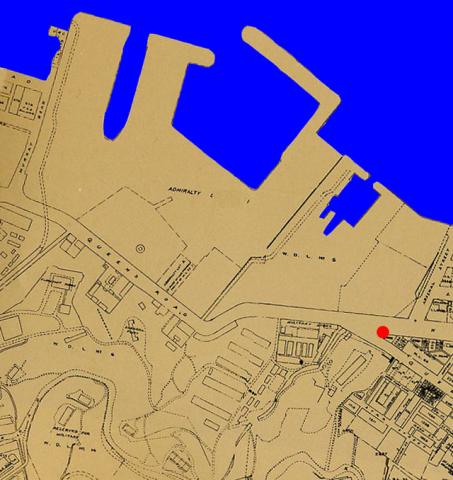
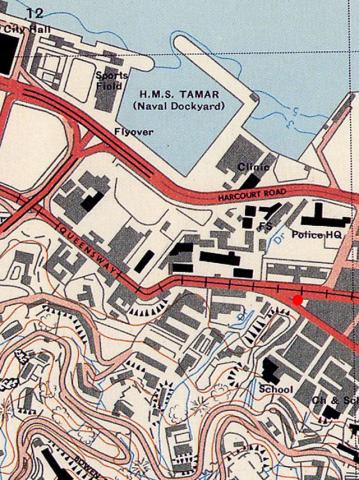

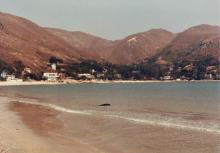
Comments
During the 70's the
Immigration @ Queensway
Comment received via email:
MrB
Queensway then
Dockyards in the 1940s
The three docks can be clearly seen in this photo by Hedda Morrison. The dry dock looks to have had the sewater pumped out at the time the photo was taken. (Click 'View Enlargement' for a better view).
MrB
Dockyards in the early 1900s
MrB
The Queens' Road / Garden Road junction
Here are a few old photos we've been sent of this area:
harcourt road
often forgotten or unknown were the huge range of military buildings that occupied the land between harcourt road and queensway, and are now filled with all the buildings above and around admiralty mtr station. I love this photo of the auxiliary police heaquarters at harcourt road, taken in 1973:
http://hkclweb.hkpl.gov.hk/hkclr2/object?svc=objrtv&src=CM&itemid=VPR%24ZDMDD18UXXL8&pid=1&mime=image/jpeg
this one, from 1964, gives some more context to the area: the site occupied by the cluster of old buildings is now the location of the gold coloured building and the lippo center
http://hkclweb.hkpl.gov.hk/hkclr2/object?svc=objrtv&src=CM&itemid=GV1B9E0WROTJ5JC4&pid=1&mime=image/jpeg
re: harcourt road
Great photos, thanks. I'll have to scan a copy of a map of that area from the 1920s, that shows all the different buildings and their purposes. One small building is marked 'Surgery and chaplain room', which doesn't point to great faith in the powers of surgery!
re: harcourt road
this one shows a good overview of the whole military site - also mid-sixties but before they built the flyover
http://hkclweb.hkpl.gov.hk/hkclr2/object?svc=objrtv&src=CM&itemid=P6KDF7LPBDBWWU@B&pid=1&mime=image/jpeg
the imposing hilton is in the foreground
Re: War ships at the dock
Hi there,
I saw there were bigger war ships other than the three mine sweepers at the dock back then. Were those two destroyers?
Best Regards,
T
Missing Maps
The 1939 & 1964 Maps seem to have disappeared. Is it possible to re-add them? Thanks
re: Missing Maps
Thanks for letting me now - fixed now.
Regards, David
Tram accident
On 12 April 1964 evening a tram overturned at the double bend ('Death turn' In Cantonese words) at Victoria Barracks, today's Pacific Place. This was the first overturned accident in Hongkong Tramways history.
Joseph
Origin of the "Queensway" name
Henry Ching writes:
I seem to recall that the name “Queensway” came about because the street addresses for Queen’s Road Central began with “1” moving westward, and for Queen’s Road East with “1” moving eastward. When the Military Cantonment ceased to be, the section of Queen’s Road in between could not be numbered without changing its name.